Students will use basic addition and subtraction facts everyday for the rest of their lives, so it is extremely important they have a good foundation of knowledge on which to use and further build upon. Included below are books, online games, and other websites and resources available to enrich the learning experience of this crucial topic. The Virginia Standards of Learning covered include: 2.5 The student will recall addition facts with sums to 20 or less and the corresponding subtraction facts; 2.8 The student will create and solve one- and two-step addition and subtraction problems, using data from simple tables, picture graphs, and bar graphs, and 2.9 The student will recognize and describe the related facts that represent and describe the inverse relationship between addition and subtraction.
Book Suggestions
- Red Riding Hood's Math Adventure
- Written by Lalie Harcourt and Ricki Wortzman
- Illustrated by Capucine Mazille
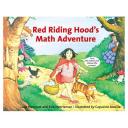 In this interactive math tale, the reader plays a role in choosing how many cookies Little Red Riding Hood gives to the fairy tale characters she meets on her way to Grandma's house. On each page there is a wheel that the reader can turn to change the dialogue and number of cookies to be shared. Readers are encouraged to use copies of the dozen cookies Little Red Riding Hood starts out with to help keep track of the subtracted cookies so some will remain for Grandma!
In this interactive math tale, the reader plays a role in choosing how many cookies Little Red Riding Hood gives to the fairy tale characters she meets on her way to Grandma's house. On each page there is a wheel that the reader can turn to change the dialogue and number of cookies to be shared. Readers are encouraged to use copies of the dozen cookies Little Red Riding Hood starts out with to help keep track of the subtracted cookies so some will remain for Grandma!
- 12 Ways to Get to 11
- Written by Eve Merriam
- Illustrated by Bernie Karlin
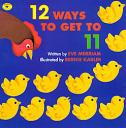 This story starts out by counting to twelve, with the number eleven missing from the list. Throughout the rest of the book, twelve different ways to add to eleven are showcased. Examples of the objects used in the number sentences include the pinecones and acorns on the forest floor, items found on a sailboat, babies, and a mother hen and her hatching chicks. Readers are exposed to a variety of number combinations that all add up to the missing number eleven.
This story starts out by counting to twelve, with the number eleven missing from the list. Throughout the rest of the book, twelve different ways to add to eleven are showcased. Examples of the objects used in the number sentences include the pinecones and acorns on the forest floor, items found on a sailboat, babies, and a mother hen and her hatching chicks. Readers are exposed to a variety of number combinations that all add up to the missing number eleven.
- Panda Math: Learning about Subtraction from Hua Mei and Mei Sheng
- Written by Ann Whitehead Nagda in collaboration with the San Diego Zoo
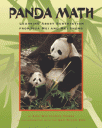 Real photographs of the panda cubs Hua Mei and Mei Sheng grace the pages of this informative non-fiction book. Readers have the option to read only the story of the baby panda cubs or they can learn more about pandas, and subtraction, as they explore the real life math issues on the left-side pages of the book. Some of the interesting math problems include how much less time pandas in the zoo spend eating bamboo compared with those in the wild or how much weight Hua Mei gained in three months. The adorable pictures and engaging facts will surely keep readers interested in both the life of the baby pandas and the math that goes along with it!
Real photographs of the panda cubs Hua Mei and Mei Sheng grace the pages of this informative non-fiction book. Readers have the option to read only the story of the baby panda cubs or they can learn more about pandas, and subtraction, as they explore the real life math issues on the left-side pages of the book. Some of the interesting math problems include how much less time pandas in the zoo spend eating bamboo compared with those in the wild or how much weight Hua Mei gained in three months. The adorable pictures and engaging facts will surely keep readers interested in both the life of the baby pandas and the math that goes along with it!
- Lights Out!
- Written by Recht Penner
- Illustrated by Jerry Smath
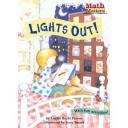 The narrator of this story is a little girl who not only has to go to bed before everyone in her family, but as she notices by the lights on in all of their windows, before everyone in the apartment building across the street. One night she convinces her parents to let her stay up until all of the thirty-two lights across the street have gone out. Throughout the night the narrator describes both some of the fun things she sees, a pillow fight and a parrot for example, as well as the steps she takes in subtracting the lights that go off, until one stubborn light remains.
The narrator of this story is a little girl who not only has to go to bed before everyone in her family, but as she notices by the lights on in all of their windows, before everyone in the apartment building across the street. One night she convinces her parents to let her stay up until all of the thirty-two lights across the street have gone out. Throughout the night the narrator describes both some of the fun things she sees, a pillow fight and a parrot for example, as well as the steps she takes in subtracting the lights that go off, until one stubborn light remains.
- Math Fables Too
- Written by Greg Tang
- Illustrated by Taia Morley
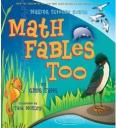 This beautifully and colorfully illustrated book provides readers with fun science facts as they read about different animals. The animals, ranging from one sea horse to ten seagulls, are described through playful rhymes that portray the animals' behaviors done in smaller groups. By breaking down the larger number of each animal, readers are exposed to a variety of different addition facts that add up to the sums one through ten, as they also learn fun facts about a variety of creatures!
This beautifully and colorfully illustrated book provides readers with fun science facts as they read about different animals. The animals, ranging from one sea horse to ten seagulls, are described through playful rhymes that portray the animals' behaviors done in smaller groups. By breaking down the larger number of each animal, readers are exposed to a variety of different addition facts that add up to the sums one through ten, as they also learn fun facts about a variety of creatures!
Web Suggestions
- A Day at the Beach Subtraction – In this activity, an ocean scene is the background for the demonstration of subtraction using colored balls. A group of the balls are crossed out and separated from the original group and students must choose which of the two number sentences provided matches the balls. After selecting it students are then prompted to answer the fact before moving on to the next sentence. After about five of these, one beach-themed word problem is given, and at the end students can color in a fun beach scene.
- Alien Addition – This game can be modified for ability levels by entering in the highest sum the facts provided will go to. In the game, students are instructed to use the cursor to move the laser beam that has the desired sum written on it below the UFO with the corresponding number sentence. They have one minute to get as many of the correct UFOs as possible before moving on to the next stage where the game continues to get harder.
- Addition Chart Surprise – Students are directed to drag the given number to a spot on the chart where the row and column add up to the sum. When they drop the number in the correct spot, the entire diagonal of facts that add up to that sum is uncovered and pieces of a larger picture are shown, which can help students visualize addition patterns.
- Number Jump – For this activity students use the calculator buttons, either to add or subtract, the number of spaces the green ball should jump to be able to smash the flies that are resting on a number. Students need to switch back and forth between the operations in order to get from one level of numbers to the next as they try to smash all of the flies in the least number of moves possible.
- Ten Frame – Available from the National Council of Teachers of Mathematics, this online ten frame allows students to choose whether they want to use the manipulative to answer how many?, build, fill, or add and a variety of fun counters are available for the students to choose from. The ten frame lets students work in terms of fives and tens, two very important numbers in our number system, which can help them develop stronger addition and subtraction understanding and skills.
Additional Teacher Resources
- Grapher – This online grapher can be used within the classroom to create bar graphs which students can then analyze. It is a great way to get students involved and connected with the subtraction facts they are working on!
- It's a Fact! – This website provides teachers with a variety of different types of activities to teach students addition patterns including counting on, doubles, doubles plus one, fact families, and combining ten. It has lists of the materials needed for each activity, including the PDF files for any forms or necessary worksheets, and step-by-step directions for each activity. There is also a list of books that go along with the topics being covered.
- Numbers Away – Very similar to the addition site above, this website provides many ideas on how to teach subtraction throughout the year. It gives activity ideas for lessons that teach subtraction using a number line, subtracting from 10, subtracting doubles, and counting up. Included are downloadable forms, step-by-step instructions, background information for teachers, a related book list, and assessment ideas.
- Manipulative Templates – This site provides teachers with templates for a wide variety of manipulatives. There are printable base-ten block sets, Cuisenaire rods, and colored tiles which would be very useful in the teaching of addition and subtraction.
